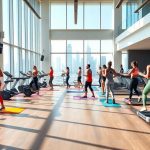Did you know that more than 60 percent of adults have insufficient levels of physical activity? Staying healthy can be a struggle. Healthcare expenses are soaring, and finding a place to start isn’t simple. But there is a way to be better and live longer. Promotion of health and fitness, that is the answer. It’s small adjustments that result in big differences.
Read on to learn how fitness and health promotion can assist you. We will define what they are, their benefits, and give you some tips to start. As well as that, you’ll discover how to conquer the obstacles you may face and where to go for help when you need it. Let’s dive in!
What is Fitness and Health Promotion?
Let’s look at a definition of fitness and health promotion. You might think it’s simple, but it’s more than that.
What is Fitness?
Physical fitness means your body is capable of doing daily work. It also means you have energy to spare for fun things. Fitness has different components. These include cardiovascular endurance, muscle strength, flexibility, and body composition.
- Cardiovascular endurance: How effective your heart and lungs are during exercise.
- Muscular strength: The amount of force your muscles can create.
- Flexibility: Your range of motion in your joints.
- Body composition: Muscle vs fat in your body.
What is Health Promotion?
Health promotion is the process of enabling people to increase control over and improve their health. Community programs, policy changes, and education on the role of plants can all help. Health promotion is about making healthy choices easier for everyone. The power of collective action, of course.
- Education: Teaching people the facts about health.
- Health Policy Changes: Policies that promote health.
- Community programs: Providing resources and activities in your community.
Research Shows the Fitness-Health Connection
Good health requires good fitness. Exercise makes your body work better. This reduces your risk of chronic conditions. It’s good for your mental health too. Exercise can relieve stress and improve your mood. Fitness improves holistic health and wellness.
Why You Should Make Fitness and Health a Priority
There are many benefits of a healthy life, both physically, mentally, and socially.
Physical Health Benefits
Fitness significantly impacts your body. It can help you maintain your weight. Exercise reduces your risk of heart disease. It can even prevent diabetes. Keeping your body moving is essential to a healthy body.
- Weight management: Helps you burn calories and maintain a healthy weight.
- Lower blood pressure and cholesterol: Reduces the risk of heart disease.
- Diabetes: Helps your body use insulin better.
Mental Health Benefits
A healthful diet and exercise pump up your mind too. They can reduce stress and increase happiness. Exercise makes your brain function better. Eating properly gives you energy and focus.
- Stress reliever: Releases endorphins, which improve mood.
- Better mood: Fights off worry and gloom.
- Cognitive function booster: Improves memory and focus.
Social Benefits
Fitness can allow you to bond with other people. Joining a sports team or a walking group can help people connect. Engaging friends and family in community events improves relationships. All of these things contribute to social wellness.
- More social interaction: Meet new people.
- Community connection: Feel part of your local environment.
- Shared activities: Enjoy healthy activities with friends and family.
Easy Tips to Get Started
Here are seven easy tips you can incorporate into your daily life.
Setting Realistic Goals
Goals help you stay on track. Use SMART goals: Specific, Measurable, Achievable, Relevant, and Time-bound. Instead of saying, “I want to get into shape,” say: “I will walk 30 minutes three times a week.”
- Achievable: Make sure your goal is attainable.
- Measurable: Track your progress.
- Relevant: Ensure your goals meet your needs.
- Time-bound: Give yourself a deadline.
Balanced Workout Routines
Exercise comes in various forms, and a good workout plan must incorporate them all. These include cardio, strength training, and flexibility exercises.
- Cardio: Heart-pumping activities like walking, running, or biking.
- Strength training: Builds muscle and increases strength.
- Flexibility exercises: Increases range of motion and prevents injury.
Nutrition for Optimal Health
What you eat matters a lot. A balanced diet is necessary for health and fitness. Reduce processed foods, sugary drinks, and unhealthy fats.
- Choose whole foods: Consume foods in their natural form.
- Avoid processed food: No packaged snacks or fast food.
- Hydrate: Drink sufficient water throughout the day.
Overcoming Challenges
Life intervenes, but here’s how to push past such challenges.
Time Constraints
Many people claim they don’t have the time. Even short workouts can help. Exercise during your lunch break if you can. Walk or bike to work. Watch TV while doing some push-ups.
- Short workouts: It’s amazing what 10–15 minutes can do.
- Active commuting: Replace driving with walking or biking.
- Movement during breaks: Squeeze in some exercise at work.
Lack of Motivation
It can be difficult to stay motivated. Find a workout buddy. Set milestones and reward yourself. Find activities you enjoy. This increases the likelihood you will stick with it.
- Find an exercise buddy: Exercise with a friend for accountability.
- Track your progress: Seeing how far you’ve come motivates you to continue.
- Incentivize milestones: Recognize achievements to stay interested.
Financial Limitations
Fitness doesn’t have to break the bank. Be creative; home workouts are entirely doable. Run outdoors or hike through a nearby park. Also, look for community fitness programs.
- Work out at home: Use free online videos or bodyweight exercises.
- Outdoor activities: Enjoy free parks and trails.
- Community fitness programs: Check out low-cost classes at local facilities.
Guides and Solutions for Health Promotion and Fitness
Don’t go it alone. Here are some resources that may help you.
Online Resources and Apps
There are many websites and apps that can help. Track your diet with MyFitnessPal. Monitor your activity with Fitbit. Access factual health information from government websites.
- MyFitnessPal: Tracks calories and macronutrients.
- Fitbit: Monitors activity, sleep, and heart rate.
- Government health websites: Provides factual health information.
Local Community Programs
You might have access to fitness and health classes in your community. Check out the YMCA, local parks, and recreation departments, or community health centers.
- YMCA: Offers gym and fitness classes for all ages.
- Parks and recreation departments: Provides access to sports facilities and programs.
- Community health centers: Offers health services and resources.
Healthcare Professionals
Talk to a healthcare provider for personal advice. Doctors, dietitians, and trainers can assist. They will help keep you on track.
- Doctors: Can evaluate your overall health and advise.
- Registered dietitians: Can help you develop a healthful eating plan.
- Personal trainers: Can guide you in creating an effective workout routine.
Conclusion
Through fitness and health promotion, you can transform your life positively. You will feel better in both body and mind. Adjusting to a few new habits can play a large role in your health and happiness.
You are not in control of everything, but you can do something. Go for a walk, eat a vegetable, drink some water. You decide how to live a healthier, happier life. Embrace fitness and health, and feel the magic of yourself!

